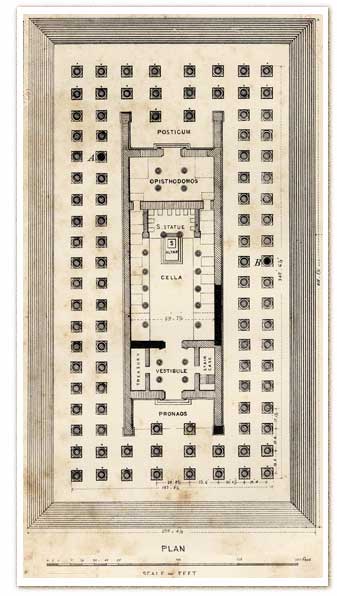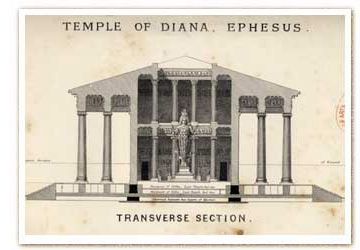

9. The Temple of Artemis, a wonder of the world
Ephesus issued coins under the Romans which depicted buildings and statues of the city that were a source of particular civic pride. The most important of these was the great Temple of Artemis ( 39 ).

Plan of the Hellenistic Artemision (J. T. Wood 1877).
The Ephesians traced the origins of their goddess' sanctuary back into the mythological past, claiming that it had been founded by Amazons who sought refuge there. Archaeological excavations hint that this was a sacred site as early as the bronze age. Remains of several successive structures and bases have been found, dating back as far as the 8th century BCE, with animal bones and precious dedications buried or scattered among them. Barbaric Kimmerians sacked the sanctuary in the seventh century BCE, but after 560 the Lydian king Croesus (famous for issuing the first gold and silver coins) helped to make the Temple of Artemis at Ephesus the most magnificent and largest building in the Greek world. It was about 55 by 105 meters, with eight immense Ionic columns with sculptured drums across its façade. Unfortunately, this building burned down in the fourth century BCE, on the same day that Alexander the Great was born; one obsequious writer even alleged that Artemis had been away presiding at the momentous birth, and so hadn't been able to save her temple. Alexander , after he had captured Ephesus, offered to fund the rebuilding, but the Ephesians preferred to do it themselves; the women of the city melted down their gold jewelry to pay for it, and the new Hellenistic temple eventually rose on the foundations of the old.

Proposed cross-section of the Hellenistic Artemision
(J. T. Wood 1877).
This is the building shown on Ephesian coins of the Roman period, and which archaeologists have reconstructed ( 40 ). Because the coins are small, their designers often had to omit or abbreviate details, yet did their best to make the building recognizable to all who held the coins in their hands. For example, the foundations of the temple show that it had eight columns on its façade; and though the coins sometimes abbreviate that number, they never show more than eight. Some coins show the Ionic capitals ( 39 ) or the famous sculptured bases of the columns, several of which are still extant; while others give us details of the superstructure that have since been lost. For example, there were three windows in the pediment, often abbreviated to one ( 34 ); and likely there were sculptured figures standing between them as well. Of course, the best way to identify the temple was to show the goddess herself standing in its façade, even if several columns had to be left out to give her room. Though her actual image was probably well under life size, she is depicted as tall as the columns; coin images are not photo-realistic.
The Temple of Artemis had the right of asylum from time immemorial, and any who sought shelter were protected. The limit of this sanctuary was set at one stadion by Alexander, and then extended by Mithradates VI of Pontus to as far as an arrow could be shot from the temple's pediment. It was then doubled by Mark Antony, so that it reached into city. Unfortunately, this brought criminals into the city itself, so the limit was reduced by Octavian soon after, and then confirmed by the emperor Tiberius in 22 CE.
Philon of Byzantium, who wrote the first canon of seven wonders around 200 BCE, included the Temple of Artemis at Ephesus as the only temple on the list, and it continued to be named as a wonder of the world long after it had sunk into decay.


